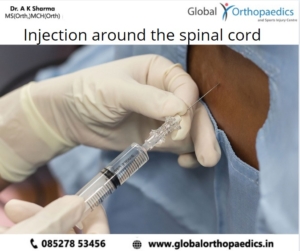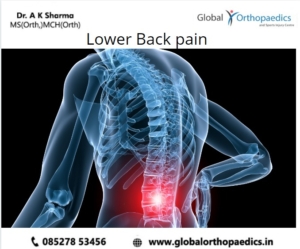Overview
The lumbar spine or lower back is a remarkably well-engineered structure of interconnecting bones, nerves, ligaments, and joints. All these work together to provide support, strength, and flexibility. This complex structure can also leave the low back susceptible to injury and pain.
Types of lower back pain:
There are two main types of lower back pain are:
• Mechanical pain:
Mechanical pain or axial pain is the most common type of lower back pain. It is primarily from the muscles, ligaments, joints (facet joints, sacroiliac joints), or bones in and around the spine.
• Radicular pain:
Radicular pain occurs when a spinal nerve root becomes impinged or inflamed. It can felt on only one side of the body.
Diagnosis of lower back pain:
The doctor will examine a back and the ability to sit, walk and movement of your leg. This activity helps to determine the pain and how much you can move. Most severe lower back pain results from injury to the muscles, ligaments, or joints.
Depending on your pain condition, the doctor can ask you for several tests:
• X-ray:
X-ray helps to show bone alignment and whether it’s broken or have arthritis. Although X-ray does not show problems with spinal cord, muscles, nerves or disks.
• CT scan or MRI:
MRI and CT scan help to reveal herniated disks or problems with bones, muscles, tissue, tendons, nerves, ligaments and blood vessels.
• Blood test:
Blood test helps to check whether you have an infection or not.
• Bone Scan:
Bone scan helps to find out any bone tumors or compression fractures caused by osteoporosis.
Treatment:
Back pain is a complex condition. For some, pain does not go away for a long period; however, only a few have persistent, severe pain.
Depending on the condition doctor might recommend the following:
• OTC (over the counter reliever):
Some nonsteroidal anti-inflammatory drugs (NSAIDs), such as ibuprofen (Advil, Motrin IB, others) or naproxen sodium (Aleve), might relieve in severe back pain. Consult your doctor before taking any medicine.
• Topical pain relievers:
These creams, salves or ointments you can rub on your skin, where you have pain.
• Muscle relaxants:
Your doctor may prescribe you Muscle relaxants if the pain is not going with the OTC.
• Injections:
If after all the above treatments, your pain expands down your leg and remains the same or increases, your doctor may inject cortisone — an anti-inflammatory medication, around your spinal cord. It helps to decrease inflammation around the nerve roots, but the pain relief lasts less than a few months.

A few people need surgery for back pain if they have unrelenting pain associated with radiating leg pain or progressive muscle weakness caused by nerve compression.



